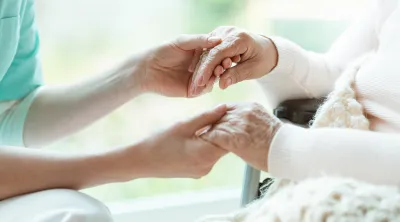Each day more than 115 people die from opioid overdoses. In 2017, nearly half a million Blue Cross and Blue Shield (BCBS) members were diagnosed with opioid use disorder, which is only a fraction of the number of Americans living with this chronic disease. That means finding effective treatments for opioid use disorder is nothing less than a matter of life or death. But treating addiction is complex, and some treatments lack evidence for effectiveness.
Now, clinicians and scientists are learning more about what works when it comes to putting patients on the path to recovery. To help advance that work, BCBS companies are investigating and investing in new approaches to treatment that meet the needs of their local communities. Here are two innovative examples.
Blue Cross Blue Shield of Michigan’s CLIMB Program Surrounds Patients with Resources When and Where They Need It
The problem: “Treatment for opioid use disorder is disjointed, episodic,” says William Beecroft, M.D., medical director for behavioral health for Blue Cross Blue Shield of Michigan’s BlueCare Network. Beecroft brings decades of experience as a clinician treating patients with addictions. “There’s no contingency planning in case of relapse, no care coordination. The patient must find his or her own path with no guide. That approach to treatment isn’t working,” Beecroft says.
The goal: Reduce relapse rates by having patients maintain medication-assisted treatment (MAT) for at least two years. Improve treatment outcomes across 15 measures, including adherence to the treatment plan and abstinence.
The approach:
- Start patients on MAT as early as possible to reduce cravings and minimize withdrawal. “Sixty percent of patients on MAT maintain their recovery versus patients given a placebo,” says Beecroft. “So it’s effective.”
- Involve the family in treatment as early as possible. Beecroft says it’s not uncommon to have a situation where significant others or family members are also misusing opioids, which could lead to higher relapse rates.
- Ensure patients receive the appropriate level of treatment when they enter the program, whether they need detoxification, stabilization, inpatient, residential treatment or continuing outpatient care.
- Develop a treatment plan with the patient that includes MAT, primary care, sober coaches, a therapist and a psychiatrist who can treat additional behavioral health issues and family.
- Encourage use of a smart phone app that provides two-way feedback on a patient’s progress. The app includes a direct link with a therapist, as well as a community of other patients living without drugs. It can alert the patient about being near a high-risk place, such as where he or she used to buy or use drugs. And it can alert the treatment team about missed doctors’ appointments or warning signs. Care team members can then reach out to the patient to determine what’s needed, including sending a nurse to provide treatment at home.
Outcomes to date: CLIMB launched in May 2018, and Blue Cross Blue Shield of Michigan will be tracking results closely. Anecdotally, the program has reduced relapse rates and increased the use of MAT. The goal is to engage 250 patients in the pilot. Of those, a growing number are using the app.
Anthem Blue Cross and Blue Shield’s Aware Recovery program brings treatment home
The problem: Studies show that medication-assisted therapy (MAT) is one powerful tool for helping patients with opioid use disorder maintain recovery. Anthem Blue Cross and Blue Shield (Anthem BCBS) offers many strategies for accessing MAT. But evidence suggests that combining behavioral health counseling with MAT can be even more effective. Anthem BCBS studied the medical claims of members who used only MAT and found that, of those members, only 16 to 19 percent were receiving the recommended counseling. Research also found that patients who spent shorter durations in inpatient or outpatient care were returning multiple times for treatment. Anthem BCBS spokeswoman Lori McLaughlin says the next question was, “How can we improve those outcomes?”
The goal: Double the percentage of patients who receive behavioral health counseling along with MAT by 2020 to help them begin their journey of recovery.
The approach:
- Pilot the approach in two states Anthem BCBS covers.
- Treat addiction as a chronic disease, not an acute episode, by delivering treatment for a full year.
- Address the shortage and lack of access to addiction treatment providers by bringing a multidisciplinary treatment team straight to the patient’s home.
- That team includes an addiction psychiatrist, supported by an addiction nurse, a licensed marriage and family therapist, individual therapist and a certified recovery advisor.
- Medication-assisted therapy can be delivered in the home by clinicians, while the certified recovery advisor focuses on teaching patients new skills and habits for living without drugs.
Outcomes to-date: The program is in early stages but, out of about 600 participants so far, most have completed the year-long program. Anthem Blue Cross Blue Shield will track these patients for a year to determine how many stay in recovery.
Blue Cross Blue Shield of Michigan and Anthem Blue Cross and Blue Shield are an independent licensees of the Blue Cross Blue Shield Association, an association of independent, locally operated Blue Cross and Blue Shield companies.

